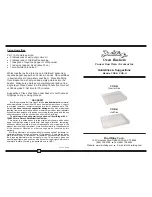
20
GGeenneerraall TTiippss
1. Due to the power required to operate the camera, flash, and
LCD screen it is a good idea to start each dive with a fresh set
of batteries.
2. Some cameras reset their flash to AUTO when the camera is
turned on. If you prefer another setting be sure to select it.
3. As soon as you enter the water, take a moment and check the
housing to see that it is properly sealed.
4. Next, check to see if there are any bubbles on the face of the
lens port. If there are, take your finger and remove them. If
there are bubbles on the lens port they can produce soft focus
spots in your photographs.
5. If you use the housing Zoom control, make sure to move it back
to the center position. If the housing Zoom control is pushing
the camera zoom lever to either side the camera will not
function.
PPhhoottoo TTiippss
1. The number one rule in underwater photography is eliminate
as much water between camera and subject as possible. Get
as close as you can to the subject, then use the zoom. If you
are using flash, subjects beyond 6 feet (1.8m)will not have
much color.
2. Digital cameras have a slight lag time between when you press
the shutter release button and the camera actually takes the
picture. Hold the camera steady a second or two after pressing
the shutter release button.
3. Do not shoot down on subjects as they will quite often blend
into the background and be difficult to see in the photograph.
Shoot subjects straight on or shoot up at a slight angle using
the blue water as a contrasting background.
17
M
Maaiinntteennaannccee
The Ikelite Digital Housing should be given the same care and
attention as your other photographic equipment. In addition to
normal maintenance we recommend that the housing be returned
to Ikelite periodically to be checked and pressure tested.
1. D
Doo N
Noott leave the camera and housing in direct sunlight for
prolonged periods. Heat may damage the camera.
2. D
Doo N
Noott ship the camera in the housing.
3. Before using the housing, always check the tightness of the
sseett ssccrreew
w in each control knob.
Check each ccoonnttrrooll ggllaanndd to make sure they are tight. There
is a slight chance that either could vibrate loose during travel.
4. Keep the back o’ring clean and lightly lubricated. To lubricate
remove the o’ring from the back. Put a small amount of lkelite
lubricant on your fingers. Draw the o’ring through your fingers
to apply a light coating of lubricant. Only apply enough
lubricant to make the o’ring feel slick. D
Doo N
Noott ssttrreettcchh tthhee oo’’rriinngg.
This light coating of lubricant will help to keep the o’ring from
drying out and will help to show a dark sealing line when the
housing back is properly sealed.
5. Keep the area where the o’ring fits and the sealing surface of
the housing clean.
6. Rinse the housing exterior in fresh water after each salt water
use. Dry with a soft cloth. Dry lens port to eliminate spotting.
After several uses in salt water soak the housing in a mild soap
solution, rinse and dry before storage. When storing the
housing, remove the back o’ring, lightly lubricate and place in a
plastic bag. Place the plastic bag with o’ring inside the housing
for safe keeping.
CCAAU
UTTIIO
ON
N
N
Neevveerr uussee sspprraayy lluubbrriiccaannttss aass tthhee pprrooppeellllaanntt iinnggrreeddiieenntt ccaann
c
caauussee tthhee ppllaassttiicc hhoouussiinngg ttoo ccrraacckk..
19
3. Some of the controls have a short shaft and cannot be pulled
out exposing the shaft for lubrication. In the unlikely event one
of these controls sticks or becomes difficult to operate you can
remove the control from the housing and lubricate it, or return
the housing to Ikelite for maintenance. To remove the control,
loosen the set screw in the knob (allen wrench required);
remove the knob. If there is salt or dirt build-up on the exposed
control shaft, clean the shaft. Open the housing and gently slide
the control shaft out of the control gland. Clean and lightly
lubricate the shaft, including the end of the shaft. Slide the
shaft back into the control gland and gently slide it back and
forth a few times without fully removing the shaft from the
gland. Replace the knob, NOTE the flat area on the shaft, the
set screw in the knob should tighten down against the flat area
on the control so the knob does not turn on the shaft.
Loosen set screw
(allen wrench required)
Flat
Tighten set screw down
against this area when
replacing the knob.
housing
gland
control
shaft
Lubricate end of shaft
before reinserting into
gland
18
CCoonnttrrooll M
Maaiinntteennaannccee
Ikelite controls are designed to provide years of reliable service
with minimal maintenance.
1. Push button controls require no maintenance other than rinsing
in fresh water after saltwater use. If a push button control
becomes difficult to push or if it sticks when depressed, soak the
housing in luke warm fresh water. After a few minutes operate
the push button. If this does not correct the problem, return the
housing to Ikelite for maintenance.
2. Some of the controls have long shafts. These controls can be
pulled out, exposing the shaft (see drawing).
To lubricate the control, gently pull on the knob until the
stainless steel shaft is exposed. Lightly lubricate the shaft, then
move the shaft in and out several times. This will lubricate the
x’ring in the Ikelite control gland. This should be done before
using the housing after a prolonged storage period, or once a
week when the housing is in use.
housing
lubricate shaft
pull out to
expose shaft
























